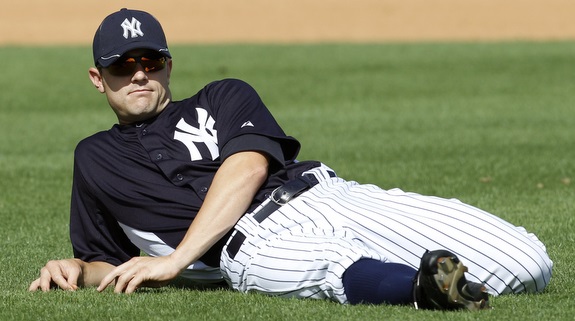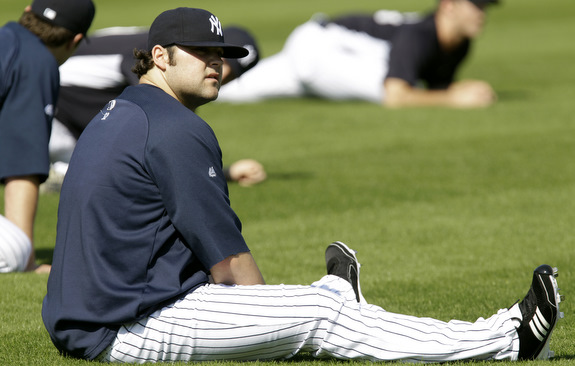
Adding Rafael Soriano to the bullpen improved the team in more innings than just the eighth. By pushing last season’s setup duo of Joba Chamberlain and David Robertson into the middle innings, the Yankees are now able to deploy a pair of super-high strikeout relievers at a point in the game when most other teams are crossing their fingers. That’s a very real advantage for the Yankees, though it’s not enough to make up for the mish-mash of has-beens at the back of the rotation.
Middle relievers are typically the most replaceable part of the roster, and in the last three years we’ve watched the Yankees shuffle guys in and out of that role until they found something that clicked. They shouldn’t have to do that this year, hopefully correcting the early season bullpen woes that have popped up in each of the last few seasons.
Best Case
Looking at Joba and Robertson as one entity of middle innings relief, the best scenario is lock down work bridging the gap between starter and the big guys in the eighth and ninth inning. So many games are won and lost in those middle innings that the tangible effect of having what amounts to two setup men available for those innings could be three or four wins in the standings. That’s the best case, obviously.
Robertson’s performance has been pretty consistent throughout his three big league seasons; he’s always had a 10+ K/9, a walk rate near 4.5 per nine, and has surrendered close to one homer for every eleven innings pitched. His ground ball rate has hovered right around 40% as well. We don’t normally think of D-Rob as a consistent guy, but overall he is. His best case scenario is basically the best of his individual peripherals, meaning a ~13 K/9 (2009) and a ~4.40 BB/9 (2008) and a ~42% ground ball rate (2008). Put that together over 60 innings of medium/high-ish leverage work and you’ve got something very close to a one win middle reliever. That guys aren’t common.
Joba’s different than D-Rob because he’s bounced between starter and reliever so much, but for the first time in his career, he was able to come into camp knowing precisely what his role will be this season. It’ll be very tough for Joba to improve on his 2010 performance in terms of the process stats, meaning his peripherals. A 9.67 K/9 with 2.51 uIBB/9 and a 45.6% ground ball rate (2.98 FIP) is as good as it gets for relievers. His ERA sucked, but blame that on the well-below average 66.6% strand rate and .361 BABIP when runners were in scoring position. If those issues regress to league average (72.2% and ~.300, respectively) and he sees slight improvement in the strikeout, walk, and ground ball rates, we’re talking one of the ten best relievers in the game. Joba’s best case basically has him showing that Soriano was completely unnecessary, a high-leverage grunting and farting monster that invokes memories of 2007.
Worst Case
As is the case with relievers, they can be pretty unpredictable and start sucking for no apparent reason. Small sample size is a part of it, these guys just don’t throw enough innings in a season for their true talent level to win out, as is (usually) the case with starters. Aside from injury, the worst thing that can happen to Robertson would be his own fault, if he starts nibbling more and more. If he does that and his walk rate climbs over 5.00 BB/9 while the strikeout rate drops below one per inning (because hitters aren’t chasing anymore), then he’s going to have a problem and is no better than Brian Bruney.
For whatever reason, some people are acting like 2010 was Joba’s worst case. I guess it was in terms of ERA and stuff like that, but we’re smarter than that (I think). There are the standard concerns, like his strikeout, walk, and ground ball rates declining for whatever reason, but it seems like Joba’s worst enemy are expectations. If he puts up Daniel Bard peripherals in 2011, he will have gotten worse. Seriously. I guess the worst thing Chamberlain could do is pitch like he did as a starter in 2009 (7.61 K/9, 4.35 BB/9, 4.82 FIP) out of the bullpen, in which case he’s just a slight upgrade over Sergio Mitre and falls into that “only when losing” cache of relievers. There’s also this rib/oblique issue, and that could carry over into the season.

What’s Likely To Happen
Like I said, relievers are incredibly unpredictable, so this section is nothing more than an exercise in guesswork. We’d like to think that we’ve seen enough of Joba and D-Rob to know what to expect out of them in 2011, but it doesn’t matter. Reliever volatility is a bitch.
One thing I do expect to see is some improvement in Robertson’s control issues. He walked 4.45 batters per nine in 2008 (30.1 IP), then walked 4.74 per nine in 2009 (43.2 IP), and then last year it was 4.84 per nine (61.1 IP), however intentional walks are inflating those numbers a bit though, especially since Robertson issued six of ’em last year. If we take those out, we’re talking about a 3.86 uIBB/9 in 2008, 4.53 in 2009, and 3.96 in 2010. Don’t get me wrong, that’s not great, but it’s a better indicator of his ability. Robertson’s never going to be a control artist, but a walk rate right around four is tolerable.
To be honest, Joba just needs to keep doing what he did last year and the success will come. He struck guys out, didn’t walk many, got some ground balls, it’s just that some of the stuff out of his control didn’t go his way. I’m encouraged by his new mechanics, but that’s probably nothing more than Spring Training optimism talking. His velocity returned in the second half, so hopefully that’s sustainable. I fully expect these two to perform like they have over the last two years, at least in terms of the underlying performance. What happens with ERA is anyone’s guess.
Leave a Reply
You must be logged in to post a comment.